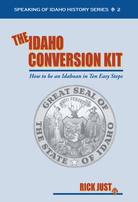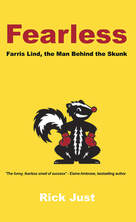Halley’s Comet last visited the skies of Idaho in 1986. We knew it was coming, so it didn’t cause a lot of fear and trepidation.
They knew Halley’s Comet was coming in 1910, too. There was much more apprehension. In 1910, earth’s orbit took the planet right through the tail of the comet for about six hours.
Speculation was rife about what would happen to the inhabitants of our home planet as a result of that close encounter.
On February 3, 1910, The Nez Perce Herald printed something of an FAQ for its readers, courtesy of Professor H.W. Hibbard of the State Normal School in Lewiston. The professor got most of it right, though he was a little off regarding the density of comets. He noted that comets are made of dust particles, so were “an airy nothing.” If a comet were to hit earth, according to the professor, “it would affect us about as much physically as a handful of confetti would affect fish in a tank of water.” This was likely not an uncommon view that didn’t take into account the icy nature of comets. According to modern scientists, if Halley’s or a comet of its size were to hit earth it would be worse than the asteroid that wiped out the dinosaurs.
But what about the tail? The planet was going to pass right through it, after all. The April 7, 1910 edition of The Idaho Statesman summed up the fears of some with the headline, “DEATH LURKS IN TAIL OF THE COMET.” The article itself was not quite so gloomy, presenting predictions from various scientists. One that gave people pause at the time was that the tail was composed of cyanogen gas, according to a French astronomer. That would cause “all human life on our planet (to be) snuffed out.”
Scientists, most of whom thought nothing terrible would happen with the passing of the comet, didn’t always make good copy. In the same article the paper quoted “prophetess, Madame de Thebes, as saying, “The year 1910 will be the one to look back to with trembling. The earth is under a terrific strain from comets and planetary revolutions. Human destiny is red. That means blood.” She added, “The strain of the stars will be most severely felt in America. The people of America will have to pay dearly for all their riches and sudden prosperity.”
Then, there were the eggs. Eggs with “comet tails” were said to portend doom associated with comets as far back as the 1700s. The first mention of weird eggs made The Statesman on April 14, 1910 with the headline “Missouri Hens Laying Eggs With Tails on Them.” The article reported eggs with an “inch-long tail” making them look something like a comet. By April 19 there was an Idaho egg found by “Little Freddie Patterson” of Eagle. The Pattersons brought the egg to The Statesman offices. A reporter described it thus: “The yolk and ‘white’ of the egg were contained in a filmy membranous tissue which was pliable to the slightest touch. Protruding two inches from the spheroid membrane was a perfectly shaped tail, composed of a hard, rocky substance.” The writer took this sign of the comet to “support the superstitious prediction of such prophets as Madame de Thebes.” Clearly. Or, maybe it was just a weird egg.
More “comet egg” reports followed, including one from Idaho City.
The comet itself pushed poultry products off the front page. It was first sighted in Boise April 13 by some intrepid citizens standing on housetops at 5:15 am, a full week before they first saw it in Chicago. Chicago likely had a comet-dimming glow in its sky even then.
Those excited by the appearance of Halley’s Comet were matched by those who feared it. A mayor who had “the strongest personal following of any commoner in Austria” committed suicide rather than be “killed by a star.”
By May 15 astronomers were reassuring the public that the dreaded gases of the tail did not, after all contain cyanogen gas to any great extent.
On May 18, the day earth was scheduled to pass through Halley’s tail, The Statesman was reporting night-long “Comet-seeing” parties around the valley, with two groups camped on top of Table Rock, where “the gleam of their fires led many of the uninitiated to believe the comet was headed for Boise on a straight line.”
The comet inspired various Halley concoctions in Boise bars and motivated some tie-in advertising (see below).
And then, it was gone. In its wake it left millions of awestruck viewers who would have a story to tell for the rest of their lives and, famously, the death of Mark Twain, comet-related only by proximity. He was born two weeks after the perihelion of the comet in 1835, and died on April 21, a day after its perihelion in 1910.
For a look at one of those weird eggs, follow this link.
For a terrific story in which Halley’s Comet plays a role, read The Whistling Season* by Montana writer Ivan Doig.
They knew Halley’s Comet was coming in 1910, too. There was much more apprehension. In 1910, earth’s orbit took the planet right through the tail of the comet for about six hours.
Speculation was rife about what would happen to the inhabitants of our home planet as a result of that close encounter.
On February 3, 1910, The Nez Perce Herald printed something of an FAQ for its readers, courtesy of Professor H.W. Hibbard of the State Normal School in Lewiston. The professor got most of it right, though he was a little off regarding the density of comets. He noted that comets are made of dust particles, so were “an airy nothing.” If a comet were to hit earth, according to the professor, “it would affect us about as much physically as a handful of confetti would affect fish in a tank of water.” This was likely not an uncommon view that didn’t take into account the icy nature of comets. According to modern scientists, if Halley’s or a comet of its size were to hit earth it would be worse than the asteroid that wiped out the dinosaurs.
But what about the tail? The planet was going to pass right through it, after all. The April 7, 1910 edition of The Idaho Statesman summed up the fears of some with the headline, “DEATH LURKS IN TAIL OF THE COMET.” The article itself was not quite so gloomy, presenting predictions from various scientists. One that gave people pause at the time was that the tail was composed of cyanogen gas, according to a French astronomer. That would cause “all human life on our planet (to be) snuffed out.”
Scientists, most of whom thought nothing terrible would happen with the passing of the comet, didn’t always make good copy. In the same article the paper quoted “prophetess, Madame de Thebes, as saying, “The year 1910 will be the one to look back to with trembling. The earth is under a terrific strain from comets and planetary revolutions. Human destiny is red. That means blood.” She added, “The strain of the stars will be most severely felt in America. The people of America will have to pay dearly for all their riches and sudden prosperity.”
Then, there were the eggs. Eggs with “comet tails” were said to portend doom associated with comets as far back as the 1700s. The first mention of weird eggs made The Statesman on April 14, 1910 with the headline “Missouri Hens Laying Eggs With Tails on Them.” The article reported eggs with an “inch-long tail” making them look something like a comet. By April 19 there was an Idaho egg found by “Little Freddie Patterson” of Eagle. The Pattersons brought the egg to The Statesman offices. A reporter described it thus: “The yolk and ‘white’ of the egg were contained in a filmy membranous tissue which was pliable to the slightest touch. Protruding two inches from the spheroid membrane was a perfectly shaped tail, composed of a hard, rocky substance.” The writer took this sign of the comet to “support the superstitious prediction of such prophets as Madame de Thebes.” Clearly. Or, maybe it was just a weird egg.
More “comet egg” reports followed, including one from Idaho City.
The comet itself pushed poultry products off the front page. It was first sighted in Boise April 13 by some intrepid citizens standing on housetops at 5:15 am, a full week before they first saw it in Chicago. Chicago likely had a comet-dimming glow in its sky even then.
Those excited by the appearance of Halley’s Comet were matched by those who feared it. A mayor who had “the strongest personal following of any commoner in Austria” committed suicide rather than be “killed by a star.”
By May 15 astronomers were reassuring the public that the dreaded gases of the tail did not, after all contain cyanogen gas to any great extent.
On May 18, the day earth was scheduled to pass through Halley’s tail, The Statesman was reporting night-long “Comet-seeing” parties around the valley, with two groups camped on top of Table Rock, where “the gleam of their fires led many of the uninitiated to believe the comet was headed for Boise on a straight line.”
The comet inspired various Halley concoctions in Boise bars and motivated some tie-in advertising (see below).
And then, it was gone. In its wake it left millions of awestruck viewers who would have a story to tell for the rest of their lives and, famously, the death of Mark Twain, comet-related only by proximity. He was born two weeks after the perihelion of the comet in 1835, and died on April 21, a day after its perihelion in 1910.
For a look at one of those weird eggs, follow this link.
For a terrific story in which Halley’s Comet plays a role, read The Whistling Season* by Montana writer Ivan Doig.
Halley's comet when it appeared in 1986.





 RSS Feed
RSS Feed